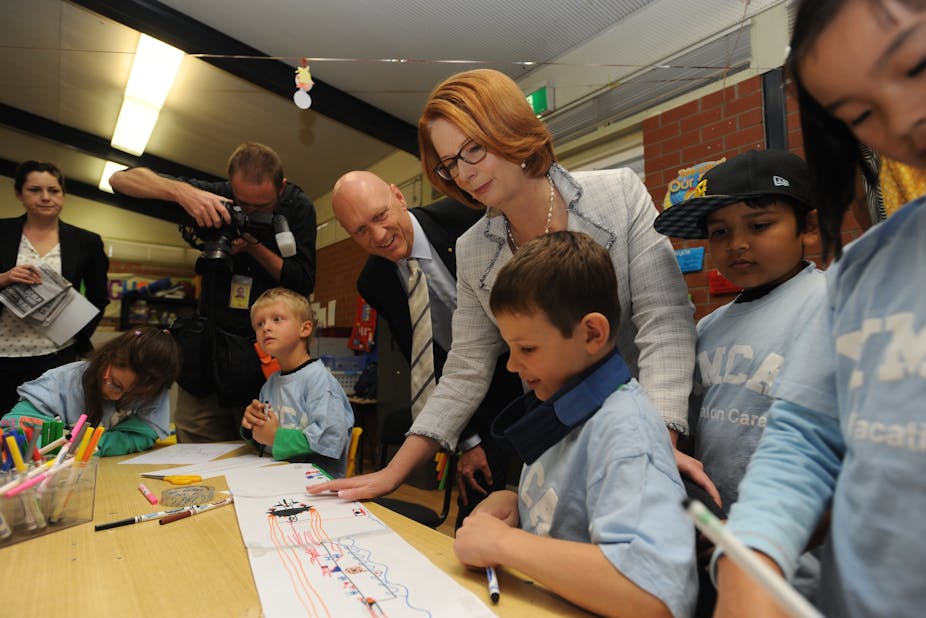Prime Minister Julia Gillard’s announcement yesterday about a new school funding and resource standard does not deliver on Gonski’s promise.
Gillard said that the plan would mean “better resourcing and better schools” resulting in “a stronger, smarter and fairer Australia for the future.”
But the goal of a fairer Australia, at least, has been hampered from the start. Once the Gillard government responded to the Gonski Review and committed to the Catholic and independent school lobbies that not one of their schools would lose a single dollar under the reforms, a fairer school funding system was lost.
Fear of being accused of creating “hit lists” of wealthy independent schools has led to the government reducing the focus on the most disadvantaged children, of whom 80% attend public schools.
Of course, if the agreement can be worked out with the state leaders, public schools will be getting extra federal funding. But the goal of a fairer, more equitable system as recommended by the Gonski review, now seems beyond reach.
Who pays for schools?
Ever since federal and state governments began to syphon funds from the public purse to top up poor Catholic parish schools, we have over four decades seen an exponential growth of government funding go to middle class and wealthy private schools at the expense of increasingly impoverished and disadvantaged public schools.
The government’s plan has lead, as Professor Richard Teese has argued in today’s media, to giving “all non-government schools real increases in funds …. This includes the 1,000 schools currently over-funded.”
According to the latest OECD statistics Australia was well above the OECD average in spending on education. But this figure is exaggerated by the significant funds that the public pays to support so-called school choice.
At the same time over the last two years public education in Queensland, NSW and Victoria has had almost $3 billion ripped out of their systems by the conservative governments, while funding for Catholic and independent schools has been maintained.
Gillard’s announcement of new school spending for primary school students of A$9,271 and for secondary students is A$12,193 is to be welcomed, but needs to be seen in the context of where the money both comes from and where it will go.
Because of her previous commitments that no school will lose a dollar in funding many over-resourced independent and Catholic schools will continue to maintain their advantage at the expense of poorer resourced public schools. At the same time public schools in middle class suburbs also stand to benefit.
The funding argument
We will surely hear opposition education spokesperson Christopher Pyne trot out once again the furphy that while education funding has increased 44% in the last decade education standards have declined, arguing that resources are not the issue but teacher quality.
This nonsensical figure derived by Dr Ben Jensen of the Grattan Institute has been used by politicians of all sides. But the facts are that apart from the 2008-2009 spending that helped save Australia’s economy from meltdown, according to World Bank figures, Australia’s spend on education as a proportion of GDP has declined from 4.9% in 1999 to 4.4% in 2011.
Figures show that only 71% of Australian government spending goes to public schools.
Only Belgium and Chile spent a lower proportion of government funding in the public sector.
Australian governments spent A$7,171 per student for those in public schools in 2008 and A$4719 for those in private schools.
The OECD average expenditure was A$8,111 per public school student - more than Australia - and A$,4572 per private school student.
The National Reports on Schooling in Australia show that government spending per student in Australia was A$8,115 in 1999-2000 ($11,731 in 2012 dollars) and A$13,544 in 2008-09 ($14,637 in 2012 dollars). That is a real increase of only 24.7%.
The ABS reports a real increase in education spending per capita of GDP over the ten years from 1998-99 to 2008-09 of 24.4%. Neither of these figures are even close to the 44% figure.
A fairer system?
But the important thing to remember is that this money comes from all taxpayers, including, of course, the 1.4 million workers on a minimum wage who are supporting well-funded private schools.
While Commonwealth funding for non-government schools rose from around $3.50 for each dollar spent on public schools, to around $5 dollars between 1997 and 2007, in the past decade government funding has increased by 112% to independent schools.
In fact, Canberra now gives more money to private schools than it does to universities – more than A$36 billion in federal funds will flow to non-government schools in the period 2009-2013.
Federal government funding for high fee private schools is six to ten times greater than the additional funding provided to disadvantaged schools.
Despite being touted as “school funding reform”, the government’s announcement this week in fact merely maintained the status quo. What was needed was a bolder political ambition for a fairer system, that doesn’t take from the poor to give to the rich.
There’s no doubt, that through its failed application of the Gonski recommendations, Labor is waging class war … against its own class.

